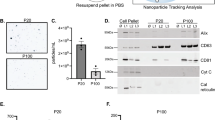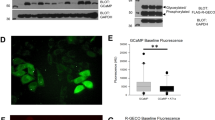Abstract
The neurotransmitter produced by autonomic neurones is influenced by the environment in which they develop1. For example, Le Douarin2 and her colleagues have shown that regions of the neural crest which normally give rise to cholinergic ganglia can be induced to develop into adrenergic cells by transplanting them into a region of the crest which normally gives rise to adrenergic ganglia. Similarly, sympathetic neurones grown in culture express either adrenergic or cholinergic properties depending on whether they are grown in the absence or presence of certain types of non-neuronal cells1,3–5. Patterson et al.6,7 demonstrated that this is not due to selective survival of a population of neurones but that the transmitter choice of individual neurones can be altered by soluble factors produced by non-neuronal cells. Like autonomic neurones, sensory neurones derive from the neural crest and it therefore seems likely that the type of transmitter they produce could also be influenced by the environment in which they develop. Here I demonstrate that when sensory neurones from embryonic chick dorsal root ganglia are grown together with ganglionic non-neuronal cells or with medium ‘conditioned’ by incubation with such cells, they produce increased amounts of somatostatin (SOM). This increase is neither accompanied by an increase in substance P (SP) content nor a detectable change in neuronal survival and thus differs from the effect of nerve growth factor (NGF), which increases survival of sensory neurones without affecting the relative levels of SOM and SP.
This is a preview of subscription content, access via your institution
Access options
Subscribe to this journal
Receive 51 print issues and online access
$199.00 per year
only $3.90 per issue
Buy this article
- Purchase on Springer Link
- Instant access to full article PDF
Prices may be subject to local taxes which are calculated during checkout
Similar content being viewed by others
References
Patterson, P. H. A. Rev. Neurosci. 1, 1–17 (1978).
Le Douarin, N. M. Nature 286, 663–669 (1980).
Varon, S. S. & Bunge, R. P. A. A. Rev. Neurosci. 1, 327–361. (1978).
Furshpan, E. J., Macleish, P. R., O'Lague, P. H. & Potter, D. D. Proc. natn. Acad. Sci. U.S.A. 73, 4225–4229 (1976).
Landis, S. C. Devl Biol. 77, 349–361 (1980).
Patterson, P. H. & Chun, L. L. Y. Devl Biol. 56, 263–280 (1977).
Reichardt, L. F. & Patterson, P. H. Nature 270, 147–151 (1977).
Hokfelt, T., Johansson, O., Ljungdahl, A., Lundberg, J. M. & Schultzberg, M. Nature 284, 515 (1980).
Hokfelt, T. et al. Neuroscience 1, 131–136 (1976).
Mudge, A. W., Leeman, S. E. & Fischbach, G. D. Proc. natn. Acad. Sci. U.S.A. 76, 526–530 (1979).
Yaksh, T. L., Jessell, T. M., Gamse, R., Mudge, A. W. & Leeman, S. E. Nature 286, 155–157 (1980).
Jessell, T. M., Mudge, A. W., Leeman, S. E. & Yaksh, T. L. 9th. A. Meet. Soc. Neuroscience Abstr. (1979).
Mudge, A. W., Fischbach, G. D. & Leeman, S. E. 7th A. Meet. Soc. Neuroscience Abstr., 410 (1977).
Henry, J. L. Brain Res. 114, 429–451 (1976).
Randic, M. & Miletic, V. Brain Res. 152, 196–202 (1978).
Phillis, J. W. & Kirkpatrick, J. R. Can. J. Physiol. Pharmac. 57, 887–899 (1979).
Mroz, E. A. & Leeman, S. E. in Methods of Hormone Radioimmunoassay, 2nd edn, 121–137 (Academic, New York, 1979).
Arnold, M. A. & Fernstrom, J. D. Neuroendocrinology 31, 194–199 (1980).
Role, L., Leeman, S. E. & Perlman, R. Neuroscience (in the press).
Greene, L. A. & Shooter, E. M. A. Rev. Neurosci. 3, 353–402 (1980).
Barde, Y. A., Edgar, D. & Thoenen, H. Proc. natn. Acad. Sci. U.S.A. 77, 1199–1203 (1980).
Kessler, J. A. & Black, I. B. Proc. natn. Acad. Sci. U.S.A. 77, 649–652 (1980).
Otten, U., Goedert, M., Mayer, N. & Lembeck, F. Nature 287, 158–159 (1980).
Jessell, T. M., Siegel, R. E. & Fischbach, G. D. Proc. natn. Acad. Sci. U.S.A. 76, 5397–5401 (1979).
Brockes, J. P., Fields, K. L. & Raff, M. C. Brain Res. 165, 105–118 (1979).
Varon, S., Nomura, J. & Shooter, E. M. Biochemistry 6, 2202–2209 (1967).
Author information
Authors and Affiliations
Rights and permissions
About this article
Cite this article
Mudge, A. Effect of chemical environment on levels of substance P and somatostatin in cultured sensory neurones. Nature 292, 764–767 (1981). https://doi.org/10.1038/292764a0
Received:
Accepted:
Issue Date:
DOI: https://doi.org/10.1038/292764a0
This article is cited by
Comments
By submitting a comment you agree to abide by our Terms and Community Guidelines. If you find something abusive or that does not comply with our terms or guidelines please flag it as inappropriate.



